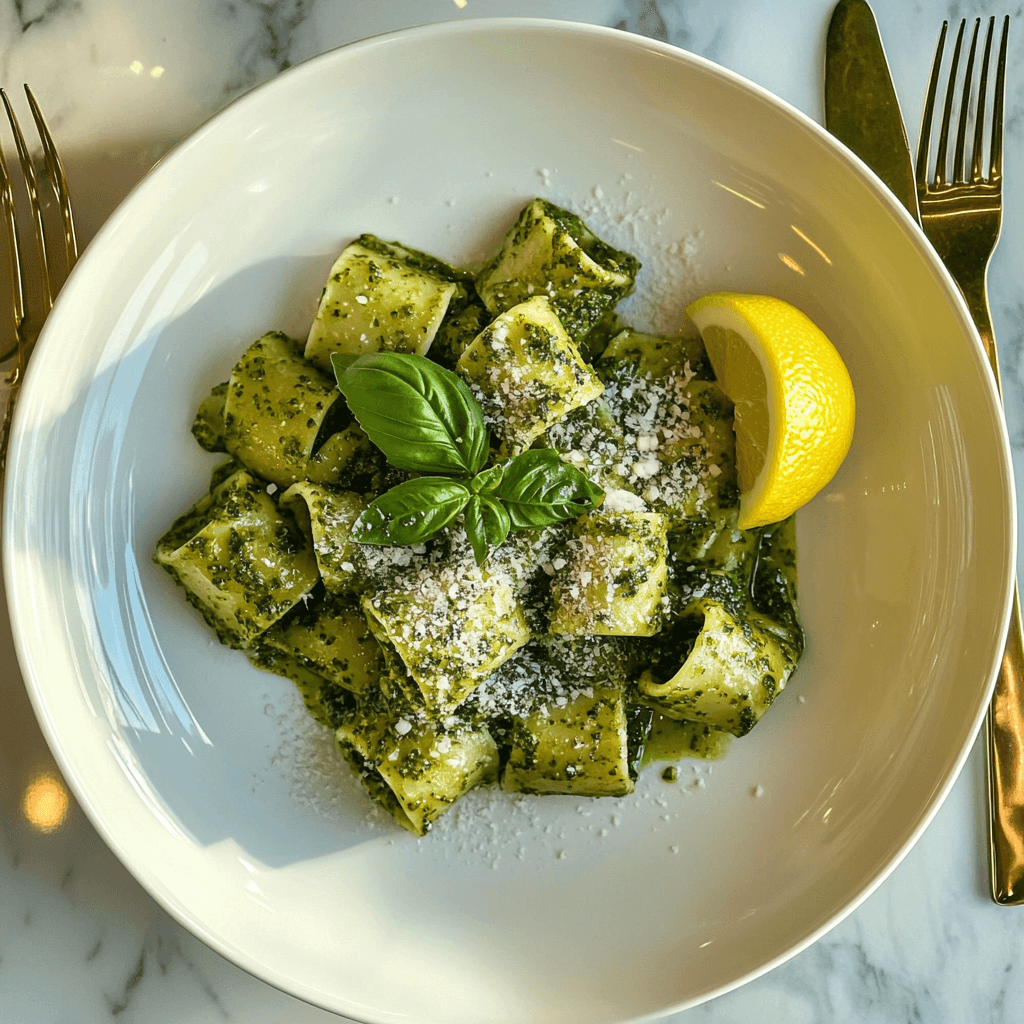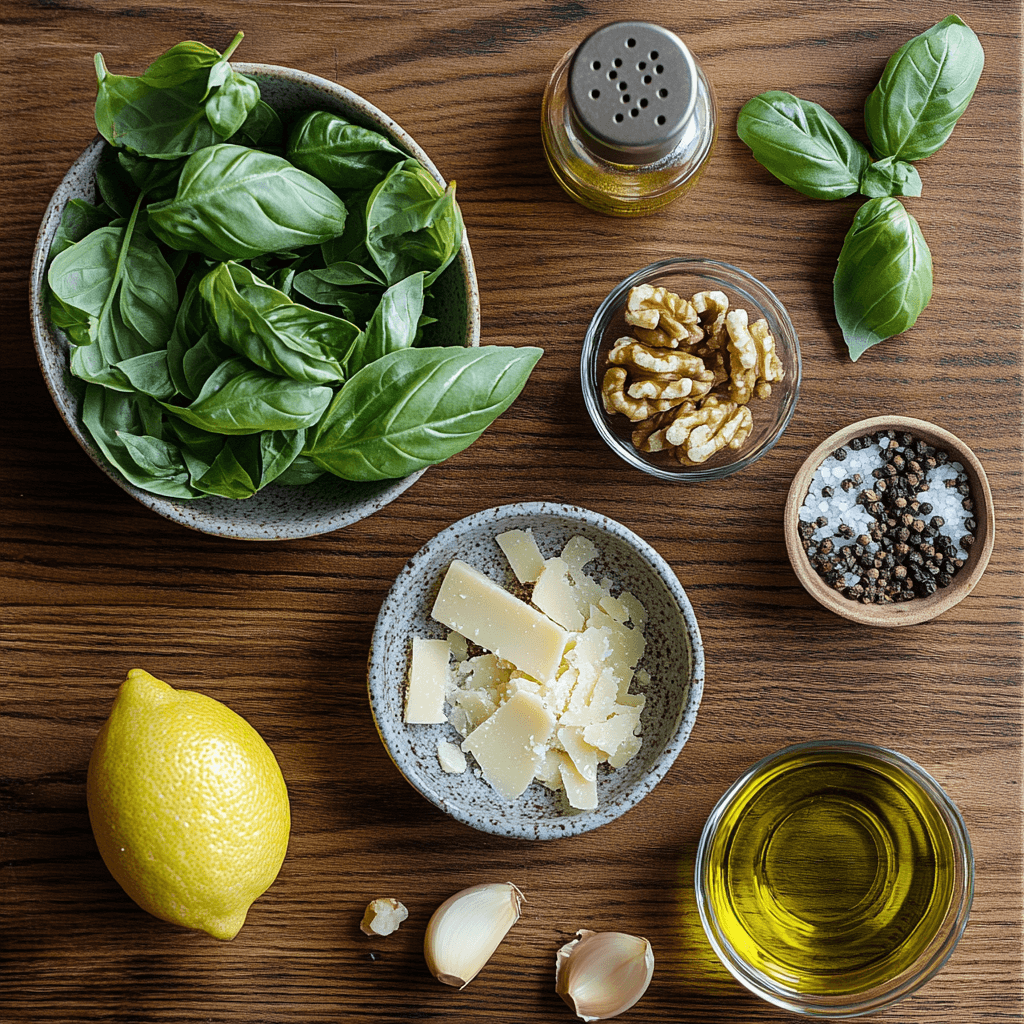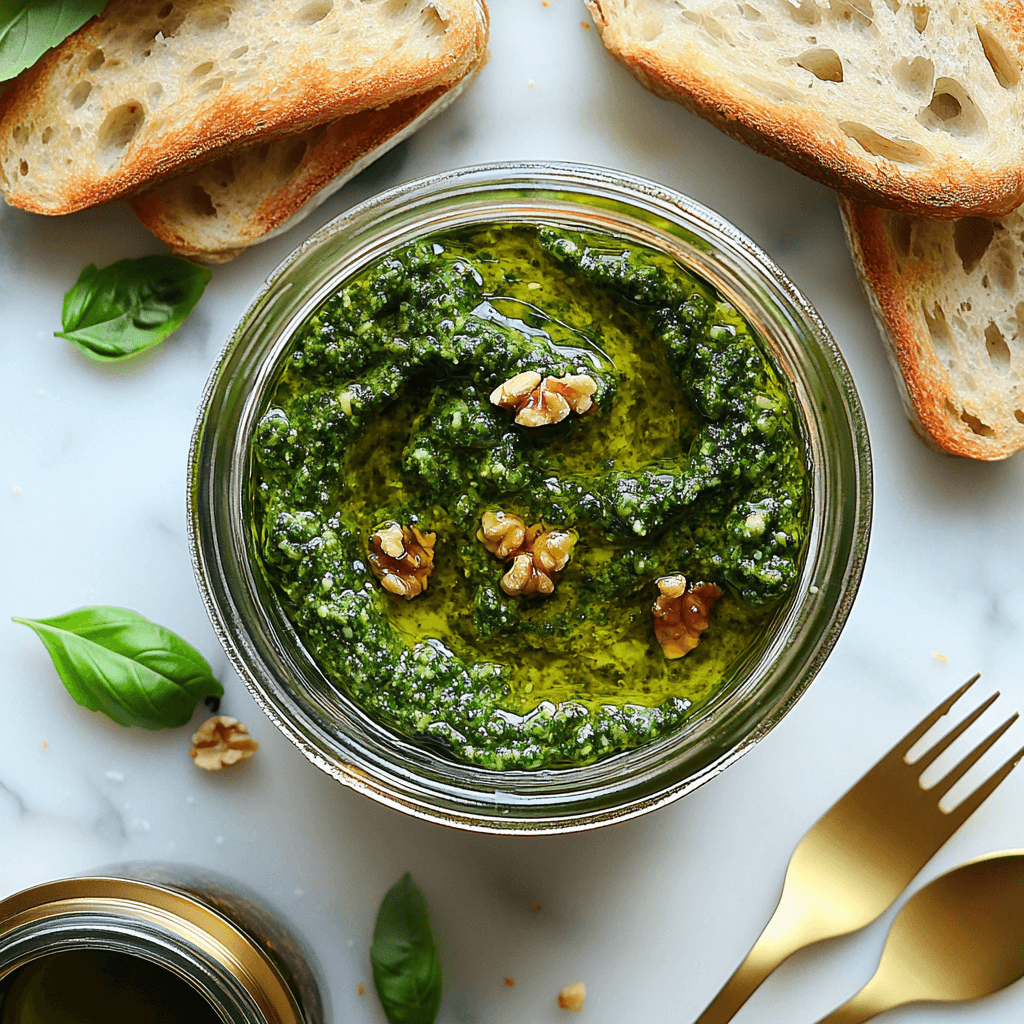Introduction
If you’ve ever fallen in love with the bold, herbal burst of classic pesto but hesitated at the steep price of pine nuts or their nutty intensity, you’re not alone. This pesto recipe without pine nuts offers all the beloved richness and vibrancy of traditional Genovese pesto, minus one ingredient. Swapping out pine nuts doesn’t just lower the cost – it also opens the door to exciting flavor variations and dietary flexibility.
Whether you’re a home chef with allergies, a budget-conscious cook, or simply craving a fresh take on a classic, this pine nut-free pesto will quickly become a staple in your kitchen. Think of silky olive oil blending with basil, garlic, lemon, and a touch of parmesan for a green sauce that sings on pasta, sandwiches, grilled veggies, or even pizza. Let’s dive into the vibrant history and versatile uses of this beloved Italian condiment.
Table of Contents

History and Origin of Pesto Recipe Without Pine Nuts
Pesto hails from Liguria, a coastal region in northwestern Italy, with its heart in Genoa. The term “pesto” derives from the Genoese word pestâ, meaning “to crush” or “to pound,” traditionally done using a mortar and pestle. The classic version, pesto alla Genovese, dates back to at least the 16th century and was originally crafted with fresh basil, garlic, pine nuts, coarse salt, Parmigiano-Reggiano (or Pecorino), and extra virgin olive oil.
Historically, pesto was a humble dish, accessible to sailors and peasants alike, valued for its intense flavor and long shelf life. Basil, native to the Mediterranean, thrived in Liguria’s climate, while local shepherds supplied the cheese. Over time, as global trade introduced new ingredients and dietary needs evolved, cooks around the world began to modify pesto.
In the modern kitchen, pine nuts have become one of the most expensive ingredients, leading to a rise in creative, cost-effective substitutions. Today, you’ll find versions made with walnuts, almonds, sunflower seeds, or even hemp hearts – each offering unique taste and texture. Pesto without pine nuts is not just a workaround; it’s a celebration of adaptability in culinary traditions.
Why You’ll Love This Pesto Recipe Without Pine Nuts
- It’s budget-friendly (no pricey nuts here!)
- Quick to make—like, 10 minutes quick
- Super versatile: toss it with pasta, spread it on sandwiches, drizzle it over roasted veggies
- Kid-approved (seriously, my picky 5-year-old calls it “green pasta magic”)
- Keeps beautifully in the fridge or freezer for busy nights
A Little Kitchen Story
The first time I made this no-pine-nuts pesto was out of sheer panic. My in-laws were coming over, I had pasta on the stove, and the pine nuts I thought I had were… somewhere else (read: not in my pantry). A handful of walnuts saved the day, and honestly? I haven’t looked back since. Now, it’s a staple in our weekly rotation.
Ingredients and Substitutions

Full Ingredient List
- 2 cups fresh basil leaves, packed
- 2 cloves garlic
- 1/3 cup grated Parmesan cheese (or Pecorino Romano)
- 1/3 cup toasted walnuts (or almonds, sunflower seeds)
- 1/2 cup extra virgin olive oil
- Juice of 1/2 lemon
- Salt and black pepper to taste
Substitutions and Dietary Alternatives for Pesto Recipe Without Pine Nut
- Nut-Free: Use sunflower seeds or roasted chickpeas for crunch without allergens.
- Vegan: Replace Parmesan with nutritional yeast or a vegan cheese alternative.
- Gluten-Free: This recipe is naturally gluten-free.
- Budget-Friendly: Walnuts or almonds cost significantly less than pine nuts and still deliver great flavor.
Step-by-Step Instructions
Detailed Cooking Steps
- Prepare the Ingredients: Rinse the basil leaves thoroughly and pat them dry. Toast the walnuts lightly in a dry skillet for 3-4 minutes until fragrant.
- Blend the Base: In a food processor or high-speed blender, combine basil, garlic, Parmesan, and toasted walnuts.
- Add Oil and Lemon: While blending, slowly drizzle in the olive oil and lemon juice until the mixture becomes smooth and emulsified.
- Season to Taste: Add salt and black pepper to your preference. Adjust lemon juice or cheese for brightness and depth.
- Store or Serve: Use immediately or transfer to a jar. Top with a thin layer of olive oil and refrigerate for up to one week.

Chef’s Tips, Common Mistakes, and Regional Variations
- Tip: Always use fresh basil for optimal flavor. Wilted leaves can taste bitter.
- Mistake: Over-blending can heat the basil and cause discoloration. Use short pulses.
- Regional Twist: In southern Italy, sun-dried tomato or chili flakes might be added for a spicy, red version.
Delicious Dishes to Pair with Pesto Recipe Without Pine Nuts
Your homemade pesto No pine nuts is as versatile as it is flavorful, and it pairs beautifully with a variety of dishes across different mealtimes. Whether you’re looking to keep things light or indulge in a hearty comfort food, these recipes from our collection will inspire your next meal:
- Quinoa and Chickpea Bowl: A wholesome, protein-rich dish that’s perfect for lunch or dinner. Stir in a generous spoonful of pesto for a burst of freshness and a layer of herbal complexity that complements the earthy chickpeas and fluffy quinoa.
- Vegan and Gluten-Free Pizza: Skip the traditional tomato sauce and spread your pesto directly onto our gluten-free crust for a vibrant, dairy-free pizza that’s big on flavor and perfect for sharing.
- Vegan and Gluten-Free Breakfast Pizza: Give your morning a savory twist with this unique breakfast pizza. A drizzle of pesto ties together the toppings and offers a fresh take on the usual breakfast fare.
- Dense Bean Salad: This nutrient-dense salad becomes even more exciting with the addition of pesto. Mix it in to coat the beans and veggies, infusing each bite with Mediterranean flair.
- Vegan Lunch Ideas: Looking for more ways to integrate your pesto into everyday meals? Explore our vegan lunch ideas for inspiration on sandwiches, wraps, bowls, and more that can all benefit from a dollop of this vibrant sauce.
Nutrition and Health Benefits of Pesto Recipe Without Pine Nuts
This pesto without pine nuts is both nutritious and satisfying. Here are some key highlights per 2-tablespoon serving:
- Calories: ~120
- Healthy Fats: Rich in monounsaturated fats from olive oil and nuts
- Antioxidants: Basil and garlic offer anti-inflammatory and antimicrobial benefits
- Protein: Walnuts and cheese provide modest protein content
- Calcium & Iron: Parmesan contributes essential minerals for bone and blood health

Serving Suggestions and Pairings for Pesto Recipe Without Pine Nuts
- Classic: Toss with spaghetti or penne for a quick, aromatic pasta dish.
- Creative: Spread on a sandwich, swirl into hummus, or drizzle over grilled chicken or salmon.
- Pairings: Serve with a crisp white wine like Sauvignon Blanc or a sparkling water with lemon.
- Plating Idea: Garnish with fresh basil leaves, grated cheese, and a drizzle of oil for visual appeal.
Frequently Asked Questions About Pesto Recipe Without Pine Nuts
1. Can I freeze pesto without pine nuts? Yes! Freeze in ice cube trays for single servings. Use within 3 months for best flavor.
2. How long does homemade pesto last in the fridge? Stored in an airtight jar with a layer of olive oil on top, it can last up to one week.
3. Can I use dried basil instead of fresh? Fresh basil is essential. Dried basil lacks the vibrant flavor and texture needed.
4. What blender works best for pesto? A food processor is ideal, but a high-speed blender works with frequent scraping.
5. Is this recipe suitable for kids? Absolutely! Reduce the garlic slightly for a milder flavor.
6. How do I reduce bitterness in pesto? Avoid over-blending and balance with a little more lemon juice or cheese.

Creative Variations and Dietary Adaptations for Pesto Recipe Without Pine Nuts
- Arugula Walnut Pesto
If you’re craving something with a little kick, swap out the basil for fresh arugula. Arugula brings a bold, peppery bite that gives your pesto a whole new attitude. Combined with the earthy crunch of walnuts, this version is a flavor-packed powerhouse. It’s fabulous on flatbreads, mixed into warm grain bowls, or spooned over roasted sweet potatoes. And bonus—it’s a fun way to sneak greens into your meals without anyone noticing. - Kale and Sunflower Seed Pesto
For those days when you want to feel like a superhuman without splurging at the health food store, kale is your leafy green hero. Rich in fiber, iron, and antioxidants, kale teams up with humble sunflower seeds to create a pesto that’s hearty, affordable, and freezer-friendly. It holds its own stirred into hearty soups, slathered on sandwiches, or tossed with whole wheat pasta for a truly satisfying bite. - Spicy Cilantro Pesto
Take your tastebuds on vacation with this zesty twist. Cilantro replaces basil, and a pinch (or more, if you’re brave) of chili flakes adds a playful kick. Add a squeeze of lime for brightness, and you’ve got a bold, aromatic pesto that’s perfect with tacos, grilled shrimp, or even swirled into a black bean soup. It’s a fiesta in a jar—and a fresh way to shake up your weeknight routine.
Recommended Kitchen Tools
- Food Processor: Ensures even blending of tough ingredients like nuts and garlic.
- Microplane Grater: Perfect for finely grating cheese or zesting lemon.
- Silicone Spatula: Helps scrape down the sides of the processor efficiently.
- Airtight Jars: Essential for storing and preserving freshness.
Conclusion
Whether you’re avoiding pine nuts due to allergies, cost, or simply curiosity, this pesto recipe without pine nuts proves you don’t need tradition to enjoy bold, herbaceous flavor. With just a few simple ingredients and a blender or food processor, you can whip up a sauce that’s perfect for pasta, pizzas, sandwiches, and beyond. The flexibility of this recipe also makes it a favorite among vegan, nut-free, and budget-conscious cooks. We encourage you to try it out, explore the variations, and experiment with new pairings—your next favorite dish might just be a spoonful of pesto away. Don’t forget to share your creations or leave a comment below to let us know how it turned out!
